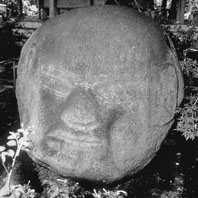

 | Page 606 |  |
America, organized in 1823 and lasting until 1839, numerous archaeological explorations were carried out by Europeans and others. In 1839 and again in 1841 john l. stephens, a New Yorker, and the Englishman frederick catherwood traveled to Mexico and Central America and visited Maya sites such as Tonina, Palenque, and Uxmal in Mexico, Quirigua, Utatlan, and Iximche in Guatemala, and Copan in Honduras. Subsequently Stephens published his account of the trips, along with drawings by Catherwood, and this helped to call the attention of the world to the subject of Maya archaeology.
The second half of the nineteenth century witnessed increasing archaeological explorations in the Peten both by Guatemalans and by foreigners. In 1848 Ambrosio Tut, a Guatemalan, discovered the ruins of tikal. He reported these to the governor of Petén, Modesto Mendez, who published information on the find in the local newspapers and in the journal of the Academia de Geografía e Historia de Guatemala. In the next few years he found more sites in the general area of Petén (Lujan 1972, 364). Toward the end of the century further exploration was encouraged by the interest of U.S. companies in obtaining chicle from the forest for the manufacture of chewing gum.

Carved monolithic head from Monte Alto
(Image Select)
Between 1881 and 1894 the Englishman Alfred P. Maudslay discovered and systematically issued reports on archaeological sites and monuments, all accompanied by excellent photographs and maps, which stimulated the first studies of Maya hieroglyphs. Slightly later the Austrian Tobert Maler discovered and photographed a number of sites along the Usumacinta River, and the results of his work were published by the peabody museum of Archaeology and Ethnology of Harvard University. The inception of coffee cultivation in Guatemala brought a number of Germans and other Europeans to the country to establish plantations, especially in the highlands. Karl Sapper, Otto Stoll, and Erwin Dieseldorff made important studies on the local ethnography and archaeology, especially in the region of Alta Verapaz.
The organization of liberal governments at the end of the nineteenth century promoted interest in pre-Columbian archaeology as a way of reconstructing national history. For this purpose Manuel García Elgueta, considered by some to have been the first Guatemalan archaeologist, carried out excavations in the highland sites of Xolchun and Chalchitan (Lujan 1972, 368). In celebration of the fourth centennial of the discovery of America in 1892, President José Maria Reyna Barrios ordered molds of monuments to be made and presented, along with archaeological objects, at the Columbian Exposition in Chicago and at another exhibition in Seville, Spain. During this endeavor the site of Ceibal in Peten was discovered by Federico Artes (Morley 1937–1938, 80). President Reina Barrios was the first government official to design laws to protect archaeological goods in the country, prohibiting the illegal excavation and exportation of these materials to other countries. The laws, however, were ignored during the following decades (Rubin de la Borbolla and Cerezo 1953, 13).
With the twentieth century came a new era in archaeological investigation in Guatemala, carried out by professional, trained archaeologists
 |  |